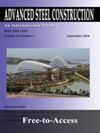火灾工况下冷弯型钢框架承重墙的热模拟
IF 1.7
3区 工程技术
Q3 CONSTRUCTION & BUILDING TECHNOLOGY
引用次数: 13
摘要
衬有石膏板的冷成型轻钢框架(LSF)墙在建筑行业中越来越多地用作主要承重构件。尽管它们已经被广泛使用,但人们对它们在实际建筑火灾中的行为还没有完全了解。已经进行了许多实验和数值研究来研究在标准火灾条件下承载LSF墙的火灾性能。然而,ISO 834[1]中给出的标准火灾时间-温度曲线并不能代表包括大量热塑性材料的典型现代建筑中存在的火灾荷载。其中一些热值高的材料会使火灾严重程度超过标准火灾曲线。暴露在真实设计火灾曲线下的LSF承重墙的火灾性能研究也受到限制。因此,在本研究中,开发了LSF墙板的有限元热模型,以使用最近开发的真实设计火灾时间-温度曲线来模拟其火灾性能[2]。根据实验室测试和现有文献,提出了石膏板和隔热材料的合适热性能。通过将开发的有限元热模型的热性能结果与现有的真实设计火灾试验结果进行比较,对其进行了验证,然后将其用于详细的参数研究。本文详细介绍了在实际设计火灾时间-温度曲线下开发的LSF承重墙板有限元热模型及其结果。研究表明,对于暴露在真实设计火灾时间-温度曲线下的石膏板内衬LSF墙的不同配置,LSF墙有限元热模型可用于预测火灾性能,包括其耐火等级,具有合理的精度。本文章由计算机程序翻译,如有差异,请以英文原文为准。
Thermal modelling of load bearing cold-formed steel frame walls under realistic design fire conditions
Cold-formed Light gauge Steel Frame (LSF) walls lined with plasterboards are increasingly used in the building industry as primary load bearing components. Although they have been used widely, their behaviour in real building fires is not fully understood. Many experimental and numerical studies have been undertaken to investigate the fire performance of load bearing LSF walls under standard fire conditions. However, the standard fire time-temperature curve given in ISO 834 [1] does not represent the fire load present in typical modern buildings that include considerable amount of thermoplastic materials. Some of these materials with high in calorific values increase the fire severity beyond that of the standard fire curve. Fire performance studies of load bearing LSF walls exposed to realistic design fire curves have also been limited. Therefore in this research, finite element thermal models of LSF wall panels were developed to simulate their fire performance using the recently developed realistic design fire time-temperature curves [2]. Suitable thermal properties were proposed for plasterboards and insulations based on laboratory tests and available literature. The developed finite element thermal models were validated by comparing their thermal performance results with available realistic design fire test results, and were then used in a detailed parametric study. This paper presents the details of the developed finite element thermal models of load bearing LSF wall panels under realistic design fire time-temperature curves and the results. It shows that finite element thermal models of LSF walls can be used to predict the fire performance including their fire resistance rating with reasonable accuracy for varying configurations of plasterboard lined LSF walls exposed to realistic design fire time-temperature curves.
求助全文
通过发布文献求助,成功后即可免费获取论文全文。
去求助
来源期刊

Advanced Steel Construction
CONSTRUCTION & BUILDING TECHNOLOGY-ENGINEERING, CIVIL
CiteScore
2.60
自引率
29.40%
发文量
0
审稿时长
6 months
期刊介绍:
The International Journal of Advanced Steel Construction provides a platform for the publication and rapid dissemination of original and up-to-date research and technological developments in steel construction, design and analysis. Scope of research papers published in this journal includes but is not limited to theoretical and experimental research on elements, assemblages, systems, material, design philosophy and codification, standards, fabrication, projects of innovative nature and computer techniques. The journal is specifically tailored to channel the exchange of technological know-how between researchers and practitioners. Contributions from all aspects related to the recent developments of advanced steel construction are welcome.
 求助内容:
求助内容: 应助结果提醒方式:
应助结果提醒方式:


